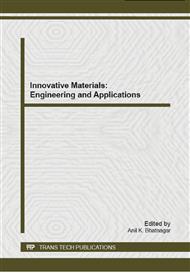p.312
p.316
p.322
p.327
p.335
p.346
p.352
p.358
p.367
An Experimental Research for Developing Prediction Program for Time to Corrosion Reinforcing Steel
Abstract:
This research has attempted to predict the level of corrosion of reinforcing bar depending on diffusion speed of chloride in concrete to develop prediction program for the time in which corrosion of reinforcing bar in concrete structure at coast occurs. Based on the results, diffusion algorithm of chloride has been formulated and corrosion prediction system has been developed by utilizing the prediction model for diffusion of chloride. The results from experiment and field investigation on coastal structure indicate that the developed program can predict diffusion speed of chloride relatively accurately, The majority of estimated values are coincide with experimental value apart from those of the surface regarding prediction on content of chloride according to different depth. Therefore, the newly developed program has been found to be useful for interpreting and predicting diffusion of chloride.
Info:
Periodical:
Pages:
335-345
Citation:
Online since:
October 2014
Authors:
Keywords:
Price:
Сopyright:
© 2014 Trans Tech Publications Ltd. All Rights Reserved
Share:
Citation:


